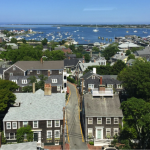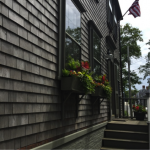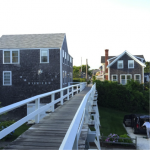
Credit: Maanvi Chawla
We understand that the built heritage of a place establishes a lot in terms of values for the place – in fact it makes up the cultural, environmental, social, and historical identity of the community. These values are entwined to form the heritage of a place, which may stand preserved or unpreserved as its built environment. At the same time, I believe that the value that usually does not get talked about and perhaps could be the most significant of all, is the economic value of heritage. On the ground, the profitability of a heritage building (to be preserved) is often the driving factor for the stakeholders and policy makers in deciding the fate of that building. I have also seen several situations where if economic gain is one of the goals of preserving a building, then it is easier to make the preservation case. Clearly, our role as professionals, which is to make heritage matter, gets easier where preservation models yield profits and this helps buildings attain cultural significance and meet other emotional and social goals.
But could it be possible that in our quest to preserve our heritage for economic value, we actually might be devaluing the intangible cultural and historical values? I believe yes, but this devaluation probably happens as an after affect of our pursuit of methodical preservation practice (even if aimed at profitability), which is to provide first aid to dilapidated heritage sites in need of rescue.
Possibly this first aid, the physical preservation of built fabric, was one of the primary needs of the island of Nantucket after mid 19th century. The island, lying off the coast of Massachusetts, was in its glory days the whaling capital of the world. I am told that decline in whaling, a huge town fire and the famous Gold Rush were reasons that caused Nantucket’s depopulation and left buildings unused and uncared for. For almost a century since that economic down turn, the deteriorating built fabric of hundreds of years sat in deep reminiscence of its grand history of prosperity, seamen and Quakerism.

Credit: Maanvi Chawla
Towards the end of 19th century the resilient community of Nantucketers, did begin promoting the island as a summer resort (among several other efforts) to bring back its economic status and welfare. But 100 years down the line, the process of recovery had not picked up much speed. Until one particular summer visitor, Walter Beinecke Jr., a business magnate from New York, saw the profit-making potential of Nantucket’s rich historic fabric and conceived of a way to make a financial profit by revamping Nantucket to its former glory. He understood that Nantucket’s dilapidated built heritage, if refurbished, could be sold as a unique value to visitors in addition to the relaxing beaches and the serene landscape.
Capitalist that he was, Walter Beinecke Jr. began with small purchases of a few properties on the island’s waterfront in 1960s; by gaining stakeholder’s trust and partnering with key organizations he established a strong hold on the island. With this hold on the island’s policy making process and with the purchase of most of the island’s water front, Beinecke began refurbishing and revamping both buildings and streets restoring their structural integrity, aesthetics and in some cases giving them a vintage look. He also began marketing and packaging the island as a holiday destination to tourists on the mainland. This well-directed redevelopment of Nantucket came with a high degree of profitability. Beinecke also controlled the ferries to the island and made sure to attract only the touristswith deep pockets, who would stay overnight on the island and spend money, whereas day-tripperswere discouraged. The revamped hotels were in the luxury class and rentals for most properties were high so as to cater mainly for the elite, deep pocketed tourists making the stays on the island an unaffordable affair for many old time visitors.

Credit Maanvi Chawla
The shabby shanties of the previously dilapidated waterfront had residents living in them before Beinecke bought and restored them as new, high end rentals. The original residents were either community members or longtime visitors to the island some of them artists and hippies; mostly people who had been on this island before the revitalization took place. With elitism and high rentals, encouraged, Nantucket soon became unaffordable and hence unlivable for these residents or natives, although rich visitors kept throngingto the island. During my reading and research, I could sense the socio-cultural change the gradually came about on the island- the delineation of visitors and natives became blurry to be renamed as ‘summer residents’and ‘year round residents’. Two decades after the ‘makeover’ as Beinecke stepped down and sold his holdings to other conglomerates, the idea of Nantucket being an affluent holiday destination only grew bigger.
Following a few decades after the redevelopment, there came a time when the local bodies struggled to maintain the original “village concept” of Nantucket. Throughout the summer that I spent on the island, I wondered about this ambiguity that could have existed at that time – the ambiguity of the local bodies being concerned about losing the originality of Nantucket when the built heritage was so effectively preserved all over the island.
Five decades down the line since the Bienecke makeover, Nantucket looks as charming as it ever did. Strict regulations in designing new buildings and tight land use zoning, an administrative change brought by Walter Beinecke Jr., has maintained Nantucket’s pristine environment and historic built fabric. However, I feel the exclusivity of this environment, being accessible only to the moneyed, has changed the way people approach Nantucket today, an approach, which perhaps even Beinecke did not intend to bring about? Maybe yes, maybe no, skyrocketing rents in the summer that lead to the annual ‘Nantucket shuffle’ (a phenomenon where year round residents have to move out their homes in summer due to the seasonal rent hike) and extremely expensive properties make Nantucket a destination only for a handful that can afford being here. I am told that a century ago, one could take pride in being a Nantucketer only if he/she were born and also raised on the island; I believe pride still exists except it is less about being a Nantucketer and more about owning a grey-shingled house on Nantucket.
Personally, I sense a lack of that intangible link between this rich, historic backdrop of heritage buildings and the fashionable summer residents who wish to make a statement about their presence on the island. Perhaps these two impermeable layers, that of well preserved historic built environment and the trendy visitors/residents, need the connect through the native spirit that was once evident on Nantucket.
A subtle example of this native pride, the intangible culture caught my eye this summer and unbelievably so, among the millennials of the island! Young men who spoke of their roots being on the island were observed to be sporting sideburns, those heavy beard patches near the ears, like the yesteryear sailors and whaling captains. Nothing can be presumed about this preference of their appearance but it clearly set them apart from the men who were just visitors/summer residents. I strongly feel that such spoonfuls of intangible cultural heritage (intentional or unintentional) are great way show regard to the rich history of the island. More meaningful solutions about valuing the history of Nantucket could connect the architectural treasures preserved by Beinecke to the realm of today. There could to be more on the island that speaks of the cultural history besides the Whaling Museum. For example, an adaptive reuse scheme for the iconic roof decks that were once used by families of sailors or a special day marked to celebrate the historical Quaker values.
Perhaps the native, cultural pride is needed to be the essence of the built heritage and not elitism. Verily, I believe so.
Maanvi Chawla is an architect working in Srinagar India. The summer of 2015 she was an international intern for US/ICOMOS on Nantucket Island sponsored by Preservation Institute: Nantucket which is associated with the historic preservation program at University of Florida. For her internship, she was assigned research work for the ‘Beinecke Book project’ which is involves the entrepreneur Walter Beinecke Jr., the man who contributed with his business ideas and preservation efforts towards the heritage of the island



4 Responses
I appreciated the author’s evaluation of the potential unintended consequences associated with historic preservation on Nantucket. I began visiting the island in the mid-sixties and noticed changes through the 1990s. Our family always enjoyed our summer weeks there and the freedom we could give our daughters to roam on their bikes and walk to the Dreamland Theater In the evening on their own. We miss the old Nantuxket.
Thank you, Kathleen. I am glad you found it interesting.
Very well written Maanvi. What you dealt with in your writing is the plight of many culturally rich places in the world. I enjoyed reading this.
Thank you, Pooja! Glad you enjoyed reading it.